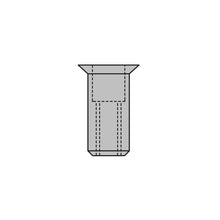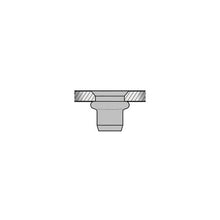
SPECIFICATIONS
• Product type: Standard alu
• Head shape: Countersunk Head (90°)
• Rivet diameter Ø: M4 | M5 | M6 | M8 | M10 [mm]
• Rivet body length: Please refer to cataloger
Contact us on info@hkgsp.com for best price now!
Follow us on:  https://www.facebook.com/gsphk
https://www.facebook.com/gsphk
JOINING ELEMENT WITH THREAD
GESIPA® blind rivet nuts and blind rivet studs are joining
elements used to produce load-bearing, high stress
threads for non-permanent connections. Blind rivet nuts
have an inside thread whereas blind rivet studs have
an outside thread (threaded pin). As with blind rivets,
two or more components can be joined with both joining
elements.
APPLICATION-OPTIMISED JOINING ELEMENTS
By manufacturing the joining elements ourselves at the
GESIPA® production sites we are able to implement
specific customer requirements economically and efficiently.
We are the specialists for application-optimised
blind rivet nuts and blind rivet studs.
APPLICATIONS
Blind rivet nuts and blind rivet studs are used in the
most diverse areas of trade and industry – wherever a
strong, non-permanent connection needs to be made.
For example:
• Automotive
• White goods
• Heating and air conditioning
• Electronics
• Solar
• Construction
• Food
MADE IN GERMANY
Tools and fasteners that are
Made in Germany. At our three
German locations, we manufacture
top-quality blind rivets
and setting tools for international
demand.
What Is A Blind Rivet Nut?
In principle, a blind rivet nut is a threaded hollow rivet. It can be set blind – that is to say, with access from only one side – in a workpiece. It is precisely this level of simplicity that makes blind rivet nuts such a smart solution. GESIPA® blind rivet nuts are fasteners used to create highly durable threads for non-permanent connections – in thin workpieces that can only be accessed from one side in particular. In the case of hollow profiles and components with one-sided access, setting blind rivet nuts is often the only way to create a thread in thin or soft components. This process allows threads to be added in just a few simple steps and with guaranteed speed, safety and reliability. GESIPA® blind rivet nuts and setting tools
are perfectly coordinated with one another. Minimum wear, short processing times and a long service life characterise GESIPA® riveting tools, making a significant contribution to cost optimisation. By manufacturing the fasteners ourselves at the GESIPA® centres of excellence, we are able to implement specific customer requirements economically and efficiently. Blind rivet nuts are used across many diverse areas of trade and industry – wherever a strong, non-permanent connection needs to be made. Examples include the automotive, white goods, electronics, food, solar and heating and air conditioning industries.
BLIND RIVET NUTS – TERMINOLOGYThe setting head is the part of the blind rivet nut that rests on the visible surface of the component. The user can choose between the following variants: A blind rivet nut with a dome head provides a large contact surface on the component. If you are looking for minimum overlap of the blind rivet nut, thus allowing the assembly component to rest so it is almost flat, a blind rivet nut with a small head is the ideal option. Finally, there are countersunk blind rivet nuts, which are perfect for flat surfaces in countersunk holes. The shank is the part of the blind rivet nut that deforms during the setting procedure and fixes the blind rivet nut in the component. What is known as the closing head is formed in this process. The user can choose from the following shank variants: a round shank, a splined shank and a polygon shank (hexagon or square).
It is down to the customer to select the material used.Specific to the application, you can use blind rivet nuts made from steel, aluminium, monel or stainless steel.

How To Installing?








